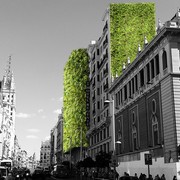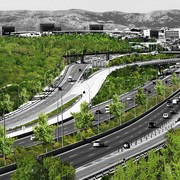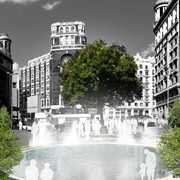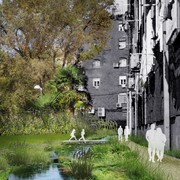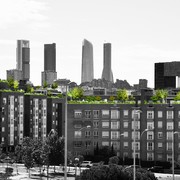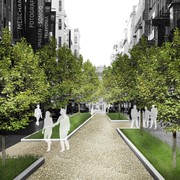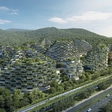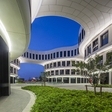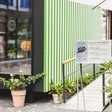
"Madrid + Natural" project as envisioned by Arup is a series of guidelines on how to address the global problem of climate change from the local perspective, including ideas for greening buildings, infrastructures and open spaces in the capital city of Spain, the wonderful Madrid.
Madrid + Natural report reveals various nature-based solutions, developed in order to enrich and regulate the capital's urban environment, while tackling issues such as pollution, heavy storm events increase, draught, periods of abnormally hot temperatures or local biodiversity loss. It was prepared by ARUP, an independent multinational firm of designers, planners, engineers, consultants and technical specialists offering a broad range of professional services, from carbon management, renewable energy, waste to energy solutions, sustainable infrastructure design, to water and wind engineering.
One of the problems most major cities all over the world are facing with is the increasing population density and shortage of space at ground level. Hence, many cities look for solutions in vertical architecture. To make the new types of living areas more eco-friendly, in Madrid vertical green landscapes, installed on 'unused' façades, are said to become popular. Green walls are set up to improve air quality and acoustics, but they also protect the buildings from thermal fluctuations and extreme weather conditions.
While the green walls look very appealing, their maintenance costs could become rather 'appaling', but developers believe that using existing structures combined with a smart selection of plant species will lead to lower expenses. Some of the green wall-related projects include Vegitecture supersized green wall (already implemented in Barcelona) and the so-called City Tree (a freestanding 'living display panel' consisting of 1,682 individual plant pots arranged in a vertical concrete grid or configured in a way to display a corporate logo or scannable QR code).
Another green idea for Madrid is the sustainable roof - no stranger to many cities around the world. Planting trees and various other roof vegetation has so many advantages - reducing ambient temperatures, supporting water management, improving insulation and air quality, providing cooling during hot summer days, and creating extra-ordinary habitat for biodiversity. Roofs can be equipped with biosolar panels or used as 'facilities' for urban beekeepers, as done in Oslo and Berlin).
Another way of making use of roofs is painting them white (with a sun-reflecting paint or utilising materials such as light-toned gravel), which is a rather low-cost solution, efficiently reducing energy consumption during hot summers, while minimising the urban heat island effect.
By greening existing (and/or obsolete) infrastructure humans can provide natural habitats for wildlife and spaces for people to enjoy (recreation, walking, relaxing), representing a strong and meaningful contrast to the proverbial "concrete jungle". Green crossings, overpasses and bridges over highways, for example, offer animals a safe way to get to the other side of the busy road (or waterway). The living standard and quality of everday life can be substantially improved by greening the residential areas and streets - tree-lined streets, for example, offer shade, filter car pollution and offer some sense of community and bonding in a particular neighbourhood.
Other projects also include river stream restoration (re-meandering rivers and reducing their canalisation), permeable paving and soft landscaping as seen in pocket parks (improves water absorption and slows rainwater run-off), urban farming (growing crops on rooftops and unused spaces between buildings, connecting the community), adaptive planting, creating urban forests and urban microclimates with water.
How does your city cope with modern problems of urban living? Are you familiar with your city's sustainability plans?
For more green ideas you can follow Arup on Facebook and Twitter.
